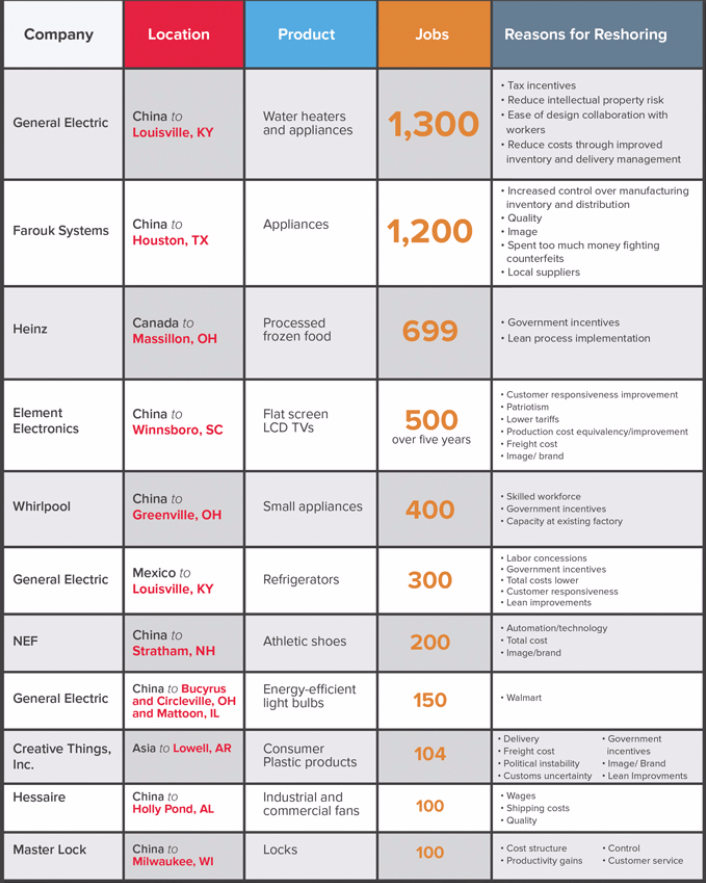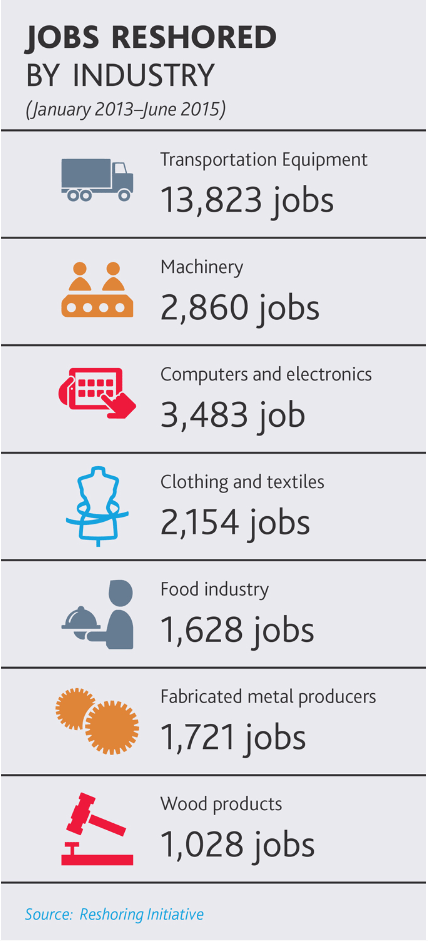By Tom Stringer, Michelle Cammarata
U.S. manufacturing is on the rebound, having added more than 730,000 jobs since the end of 2010. And industry analysts expect the sector to create at least another 700,000 jobs by the end of the decade, according to the Manufacturing Institute.
Many of these jobs are the result of the return of operations to the U.S. from abroad, also known as reshoring. Companies are exhibiting a strong commitment to reshoring, and a December 2015 study by The Boston Consulting Group found that:
- 54 percent of companies with more than $1 billion in revenue are considering reshoring
- The share of executives saying that their companies are actively reshoring production increased by 9 percent since 2014 and by almost 250 percent since 2012
- Of manufacturers planning to add production capacity over the next five years for goods consumed in the U.S., more plan to add that capacity in the U.S. than in any other country
Perhaps no company has had a bigger impact on the reshoring trend than Walmart. The retailer has committed $250 billion for U.S.-made goods over the next decade and reshored 4,444 jobs between 2010 and 2014, according to the Reshoring Initiative. This has set in motion a chain reaction, as suppliers are reshoring their own operations to serve the retail giant.
U.S. automakers are also making significant investments. Ford, second only to Walmart in reshoring over the past five years, brought 3,250 jobs from Mexico to Michigan and Ohio and moved 1,800 jobs to Tennessee. General Motors also brought 1,800 jobs from Mexico to U.S. plants, according to analysts at the Reshoring Initiative.
Reshoring is strongest in the southeast and Texas. Companies building new facilities frequently choose right-to- work states with comparatively lower wages and business taxes. Companies that move operations to other regions typically choose existing factories with excess capacity. For example, in 2014 Whirlpool announced it would relocate production of KitchenAid small appliances from China to an existing facility in Greenville, Ohio, adding 400 workers.
Why Businesses Reshore Jobs
Costs: Two major costs–labor and energy–are dramatically reduced for many companies when they reshore. The cost of labor in China has increased 320 percent since 2000, according to the Reshoring Initiative. Gas and oil prices, volatile in other countries, have been lower and more stable here in the United States, and few predict that will change in the near term.
Logistics: Reshoring shortens the supply chain and cuts time to market, helping companies be nimbler.
Brand Building: Businesses boost their brands when they can market their products as “Made in America.” Companies enjoy better quality control and access to skilled labor, which can improve the product, further strengthening their brands.
Who will fill the jobs?
Add existing manufacturing sector growth, plus reshoring, plus the pending retirement of the baby boomers, and U.S. manufacturers say there will be as many as 3.5 million job openings over the next 10 years, according to a 2015 GE Reports study by General Electric. Meanwhile, according to the Reshoring Initiative, there are still 3-4 million manufacturing jobs abroad, offering a chance for enormous economic growth if reshoring continues.
The U.S. might not have enough skilled manufacturing labor–today or in the pipeline–to meet this demand. Several factors contribute to the gap:
- Perception: After years of layoffs, plant closings and relocations to emerging markets like China and Mexico, the industry has struggled to attract younger talent. While initiatives like Manufacturing Day are making strides to cultivate a new generation of manufacturers, a 2015 study from the Manufacturing Institute reports that just 37 percent of parents would encourage their children to pursue careers in manufacturing.
- Demand for technical skill: U.S.-based manufacturing jobs today focus on operating, maintaining and programming high-tech machines. Employers need problem solvers with strong technical skills. Unfortunately, inadequate investment in manufacturing education, vocational schools and community colleges, along with a decline in apprenticeship programs, have contributed to the skills gap.
- Wages: Concerns about wages may push otherwise qualified workers away from a manufacturing career. While automakers have reshored jobs, for example, some have moved to areas where wages and benefits are lower. Increases in manufacturing pay are struggling to keep pace with the influx of jobs to fill.
Experts note that these hurdles are not insurmountable, and several strategies are already yielding progress. As the cost of doing business abroad continues to rise, manufacturers are heading home to take advantage of lower costs, more efficient logistics, stronger protections for intellectual property and a boost to their brands. Job opportunities abound for employees with the technical skills and problem-solving ability to operate and maintain high-tech equipment and engineer new products. By collaborating to offer educational programs and apprenticeships, leaders in business and government can grow the skilled workforce to keep pace with the rapid growth projected for the manufacturing sector for years to come.


Tom Stringer leads National Site Selection and Business Incentives for the Corporate Real Estate Advisory Services practice and can be reached at tstringer@bdo.com.
Michelle Cammarata is a director with the Corporate Real Estate Advisory Services practice and may be reached at mcammarata@bdo.com.
This article originally appeared in BDO USA, LLP’s “Real Estate Monitor” newsletter (Spring 2016). Copyright © 2016 BDO USA, LLP. All rights reserved. www.bdo.com.
